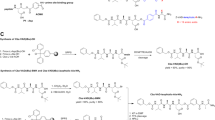Abstract
Caspase-1 selective inhibitors are novel therapeutic agents for inflammatory diseases. Selectivity assays for caspases can be initiated with purified enzyme, making these assays very costly and time consuming. Therefore, there is a need to develop a fast and reliable cell-based assay, which can be used for the selectivity screening of multiple caspases in a biologically relevant context in a single assay. In this study, we have developed an assay in which DNA fragmentation, a hallmark of apoptosis, of Jurkat cell line was examined post induction with etoposide in the presence or absence of inhibitors of caspases 1, 3, 8, 9 and pan-caspase inhibitors. We observed that caspases-3, -8, -9 and pan caspase inhibitors resulted in significant inhibition of etoposide-induced DNA fragmentation. However, caspase-1 specific inhibitor failed to prevent DNA fragmentation, suggesting that either caspases belonging to caspase-1 family (1, 4 and 5) are not present in the Jurkat cells or might not be involved in the etoposide-induced DNA fragmentation. Since the inhibition of caspases 3, 8 and 9 is accompanied by the down regulation of the activity of a cascade of caspases (caspases 2, 6, 7, 9 and 10), selectivity of caspase-I inhibitors can be ascertained for the above panel (caspases 2, 6, 7, 8, 9 and 10) of caspases from this single assay.


Similar content being viewed by others
References
Ashwell S (2001) Caspases: recent advances in small molecule inhibitors. Expert Opin Ther Pat 11:1593–1603
Cohen GM (1997) Caspases: the executioners of apoptosis. Biochem J 326:1–16
Eischen CM, Kottke TJ, Martins LM, Basi GS, Tung JS, Earnshaw WC, Leibson PJ, Kaufmann SH (1997) Comparison of apoptosis in wild-type and Fas-resistant cells: chemotherapy-induced apoptosis is not dependent on Fas/Fas ligand interactions. Blood 90:935–943
Fujino M, Li XK, Guo L, Amano T, Suzuki S (2001) Activation of caspases and mitochondria in FTY720-mediated apoptosis in human T cell line Jurkat. Int Immunopharmacol 1:2011–2021
Fujino M, Li XK, Kitazawa Y, Guo L, Kawasaki M, Funeshima N, Amano T, Suzuki S (2002) Distinct pathways of apoptosis triggered by FTY720, etoposide, and anti-Fas antibody in human T-lymphoma cell line (Jurkat cells). J Pharmacol Exp Ther 300:939–945
Iwamura H (2000) Recent advances in cytokine synthesis inhibitors. IDrugs 3:774–782
Kidd VJ (1998) Proteolytic activities that mediate apoptosis. Annu Rev Physiol 60:533–573
Li X, Darzynkiewicz Z (2000) Cleavage of poly(ADP-ribose) polymerase measured in situ in individual cells: relationship to DNA fragmentation and cell cycle position during apoptosis. Exp Cell Res 255:125–132
Muzio M, Chinnaiyan AM, Kischkel FC, O’Rourke K, Shevchenko A, Ni J, Scaffidi C, Bretz JD, Zhang M, Gentz R, Mann M, Krammer PH, Peter ME, Dixit VM (1996) FLICE, a novel FADD-homologous ICE/CED-3-like protease, is recruited to the CD95 (Fas/APO-1) death-inducing signaling complex. Cell 85:817–827
Okamoto Y, Anan H, Nakai E, Morihira K, Yonetoku Y, Kurihara H, Sakashita H, Terai Y, Takeuchi M, Shibanuma T, Isomura Y (1999) Peptide based interleukin-1 beta converting enzyme (ICE) inhibitors: synthesis, structure activity relationships and crystallographic study of the ICE-inhibitor complex. Chem Pharm Bull (Tokyo) 47:11–21
Sun XM, MacFarlane M, Zhuang J, Wolf BB, Green DR (1999) Cohen GM Distinct caspase cascades are initiated in receptor-mediated and chemical-induced apoptosis. J Biol Chem 274:5053–5060
Tafani M, Schneider TG, Pastorino JG, Farber JL (2000) Cytochrome c-dependent activation of caspase-3 by tumor necrosis factor requires induction of the mitochondrial permeability transition. Am J Pathol 156:2111–2121
Thornberry NA, Lazebnik Y (1998) Caspases: enemies within. Science 281:1312–1316
Van de Craen M, Van Loo G, Pype S, Van Criekinge W, Van den Brande I, Molemans F, Fiers W, Declercq W, Vandenabeele P (1998) Identification of a new caspase homologue: caspase-14. Cell Death Differ 5:838–846
Wu JC, Fritz LC (1999) Irreversible caspase inhibitors: tools for studying apoptosis. Methods 17:320–328
Zhivotovsky B, Samali A, Gahm A, Orrenius S (1999) Caspases: their intracellular localization and translocation during apoptosis. Cell Death Differ 8:644–651
Author information
Authors and Affiliations
Corresponding author
Rights and permissions
About this article
Cite this article
Chopra, P., Gupta, S., Dastidar, S.G. et al. Development of cell death-based method for the selectivity screening of caspase-1 inhibitors. Cytotechnology 60, 77–83 (2009). https://doi.org/10.1007/s10616-009-9217-9
Received:
Accepted:
Published:
Issue Date:
DOI: https://doi.org/10.1007/s10616-009-9217-9




